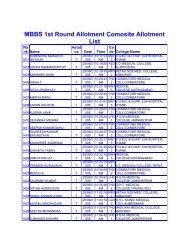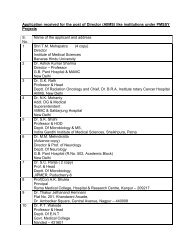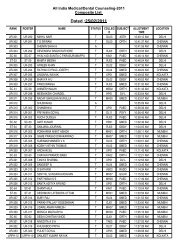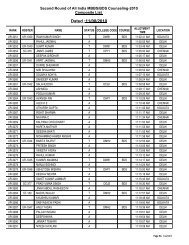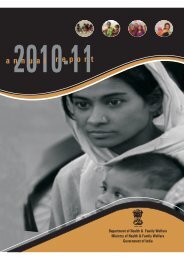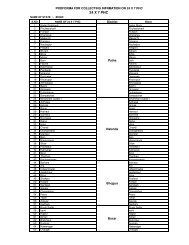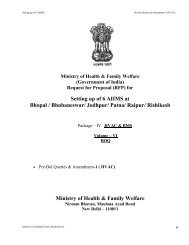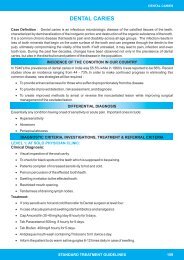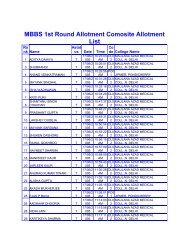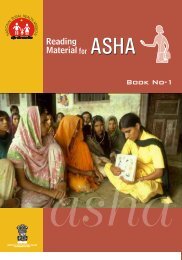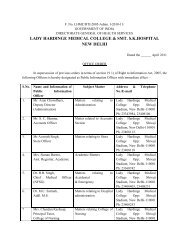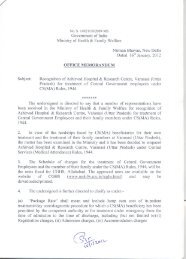National Vaccine Policy Book - Ministry of Health and Family Welfare
National Vaccine Policy Book - Ministry of Health and Family Welfare
National Vaccine Policy Book - Ministry of Health and Family Welfare
You also want an ePaper? Increase the reach of your titles
YUMPU automatically turns print PDFs into web optimized ePapers that Google loves.
4.3.1. <strong>Vaccine</strong> financing <strong>and</strong> sustainability<br />
The ideal situation for any national government is to assume<br />
ownership <strong>of</strong> NIP to the fullest extent possible <strong>and</strong> accordingly create<br />
fiscal <strong>and</strong> legislative space. Meeting benchmarks <strong>and</strong> enacting<br />
protective legislation are the essential conditions for the financial<br />
sustainability.<br />
• A financial sustainability plan (FSP) for immunization should be<br />
created. The FSP should include the breakdown <strong>of</strong> vaccine <strong>and</strong><br />
non-vaccine expenditures (system costs) <strong>and</strong> plan for scale up in<br />
the coming years. It should also factor in the changes to be<br />
brought about by the introduction <strong>of</strong> new vaccines, expansion in<br />
cold chain capacities <strong>and</strong> management.<br />
• The non-vaccine expenditure should also include expansion <strong>and</strong><br />
sustenance <strong>of</strong> trained human resource. This should clearly<br />
describe the expenditures to be met by the central <strong>and</strong> state<br />
government.<br />
• Possibility <strong>of</strong> creation <strong>of</strong> exp<strong>and</strong>ed <strong>Vaccine</strong> fund through<br />
innovative financing mechanism should be considered. An interagency<br />
task force should be created <strong>and</strong> should assess the legal<br />
<strong>and</strong> administrative barriers to make such a fund operational. This<br />
fund could also be used for introduction <strong>of</strong> new vaccines <strong>and</strong> for<br />
development <strong>of</strong> vaccine for emergency.<br />
5. INTRODUCTION OF NEW VACCINES IN UIP<br />
5.1. <strong>Vaccine</strong> selection<br />
5.1.1. Identifying vaccines <strong>of</strong> local relevance<br />
The decision to include a new vaccine should be guided by the<br />
disease burden in the country. This information, ideally, be derived<br />
through strong surveillance system within country. Furthermore, the<br />
data from the investigator initiated researches, from modeling studies<br />
<strong>and</strong> the data from countries with either geographical proximity or<br />
similar demography may also be used for these decision makings.<br />
A mid term (5-7 year) strategy on the required evidence with regard to<br />
the burden <strong>of</strong> diseases should also be in place, with scope for<br />
periodic monitoring <strong>and</strong> review. A multi-agency policy unit should be<br />
created to conduct meetings <strong>of</strong> various stakeholders to evaluate <strong>and</strong><br />
monitor these studies periodically. It could also review status <strong>of</strong><br />
vaccine development <strong>and</strong> manufacturing activities in the country <strong>and</strong><br />
arrange technical assistance in various aspects <strong>of</strong> vaccine<br />
development.<br />
5.1.2. Criteria for selection <strong>of</strong> vaccines for introduction<br />
The selection <strong>of</strong> vaccine for possible introduction in NIP is a complex<br />
process. There are a few laid down guidelines. The below given<br />
criteria may be considered for an informed decision making about the<br />
introduction <strong>of</strong> new vaccine in UIP.<br />
• Disease burden (incidence/prevalence, absolute number <strong>of</strong><br />
morbidity/mortality, epidemic/p<strong>and</strong>emic potential);<br />
• Safety <strong>and</strong> efficacy <strong>of</strong> the vaccine under consideration;<br />
• Affordability <strong>and</strong> financial sustainability <strong>of</strong> the vaccination<br />
program, even if the initial introduction is supported by the<br />
external funding agency;<br />
• Program capacity to introduce a new antigen, including cold chain<br />
capacity;<br />
• Availability <strong>of</strong> a domestic or external vaccine production capacity;<br />
• The cost effectiveness <strong>of</strong> the vaccination program <strong>and</strong> also <strong>of</strong> the<br />
alternatives other than vaccination.<br />
The Grades <strong>of</strong> Recommendation Assessment, Development <strong>and</strong><br />
Evaluation (GRADE) system is one such system followed, which<br />
allows a systematic <strong>and</strong> transparent grading <strong>of</strong> evidence with<br />
deliberate separation <strong>of</strong> quality <strong>of</strong> evidence <strong>and</strong> strength <strong>of</strong><br />
recommendation.<br />
5.2. <strong>Vaccine</strong> formulations <strong>and</strong> immunization schedules<br />
There are a number <strong>of</strong> new vaccines, which may be considered for<br />
the possible introduction in UIP in India. The modifications in the<br />
existing immunization schedule may be required for accommodating<br />
these new vaccines, for a broader utilization <strong>of</strong> some vaccines or for<br />
changing the number <strong>of</strong> doses based on experience elsewhere.<br />
• Technical consultations should be carried out to examine the<br />
possibility <strong>of</strong> any alteration in vaccine formulation (e.g. vaccines<br />
with or without preservative, with or without adjuvant, liquid or<br />
lyophilized etc.) that could enable the use <strong>of</strong> a vaccine in the<br />
16 17




